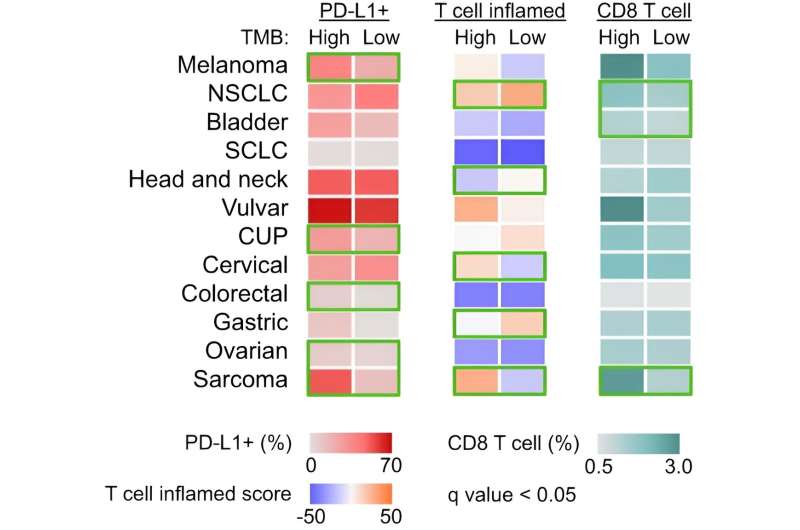
Immune correlates between TMB-high and TMB-low cancers using the earliest cutoff at which ICIs are predictive. PD-L1 positive cell frequency, T-cell inflammatory score, and CD8 + T cell frequency are compared between TMB-high cancers and TMB-low cancers using the earliest cutoff at which ICIs are associated with OS benefit. Credit: Nature Cancer (2024). DOI: 10.1038/s43018-024-00752-x
The number of mutations in the DNA of cancerous tumors may not be an indicator of how well patients will respond to immune checkpoint inhibitors (ICIs), a commonly prescribed type of immunotherapy, a team led by UT Southwestern Medical Center researchers reported in a retrospective study.
The findings, published in Nature Cancer, upend long-held conventional wisdom and could lead to more effective ways of deciding which patients will benefit most from this type of treatment.
“Our study challenges the paradigm that tumor mutational burden is a universal marker of how immunogenic a cancer will be. Current standards that rely on this assumption could lead to both undertreatment and overtreatment of patients,” said study leader David Hsieh, M.D., Assistant Professor of Internal Medicine in the Division of Hematology and Oncology and a member of the Harold C. Simmons Comprehensive Cancer Center at UT Southwestern.
ICIs have revolutionized therapy for several cancer types since the first drug in this category was approved by the U.S. Food and Drug Administration in 2011. Seven other ICIs have since joined the U.S. market. They all work by blocking protein checkpoints that prevent the immune system from attacking cancer cells.
Although ICIs can significantly extend survival, clinical trials have shown that they work in only a fraction of patients, with the number of mutations present in cancer cells thought to be a reliable predictor of ICI success.
For example, pembrolizumab—an ICI commonly prescribed to treat a range of cancers including melanoma, non-small cell lung cancer, and renal cell carcinoma—is approved for patients whose tumors have 10 or more mutations per million base pairs of DNA and whose cancers have progressed on standard treatments.
However, Dr. Hsieh said, the idea that tumor mutation burden (TMB), or the number of mutations present in a tumor, is a consistent marker of how well ICIs will work could be a faulty assumption. The studies forming the basis for this idea were relatively small and included a limited number of cancer types. In addition, he said, the cutoff of 10 or more mutations used to prescribe pembrolizumab was based on weak evidence.
To determine how TMB relates to outcomes with ICI, Dr. Hsieh and his colleagues relied on a database managed by the Caris Precision Oncology Alliance, a group of more than 80 leading cancer centers and academic medical centers, including UT Southwestern. The database includes de-identified genetic information on hundreds of thousands of malignant tumors derived from patients with many different cancer types.
The researchers used this database to analyze TMB in 70,698 tumors of 27 different types of cancer. The data involved 14,736 patients treated with ICIs that target an immune checkpoint protein known as PD-1/L1 and 55,962 who never received an ICI. The researchers then compared TMB with patient outcomes in both groups.
Results showed that TMB predicted ICI benefit in only 12 of the 27 cancer types. Among those 12 cancer types, the TMB thresholds for ICI benefits were far fewer than 10 mutations per million base pairs of DNA and varied widely between cancer types, suggesting that the cutoff for pembrolizumab use was arbitrary.
In some cancer types examined in the study, TMB was associated with improved survival for patients who never received an ICI. In others, survival was worse, suggesting that mutation burden may have independent effects on patients’ prognoses regardless of whether they received immunotherapy.
Since TMB was thought to stimulate immune activity, Dr. Hsieh explained, doctors have often used immune factors—such as whether a tumor had relatively high numbers of infiltrating immune cells or produced more PD-1/L1—as proxies for TMB.
To determine whether these assumptions were accurate, the researchers compared TMB with information in the Caris database from tumor biopsies. While some tumors with high TMBs had features suggesting increased immune activity, others didn’t, suggesting that these features weren’t reliable proxies.
Dr. Hsieh said that these findings showed that TMB is not a reliable indicator of whether ICIs will improve outcome—a potential paradigm shift for the field. More research is necessary, he added, to boost cancer patient outcomes with ICI.
More information:
Maishara Muquith et al, Tissue-specific thresholds of mutation burden associated with anti-PD-1/L1 therapy benefit and prognosis in microsatellite-stable cancers, Nature Cancer (2024). DOI: 10.1038/s43018-024-00752-x
Citation:
Tumor mutations may not predict response to immunotherapy, study finds (2024, May 23)
retrieved 23 May 2024
from https://medicalxpress.com/news/2024-05-tumor-mutations-response-immunotherapy.html
This document is subject to copyright. Apart from any fair dealing for the purpose of private study or research, no
part may be reproduced without the written permission. The content is provided for information purposes only.
>>> Read full article>>>
Copyright for syndicated content belongs to the linked Source : Medical Xpress – https://medicalxpress.com/news/2024-05-tumor-mutations-response-immunotherapy.html
